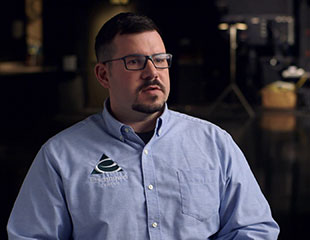Family and Mental Health Support Help Army Veteran After TBI
4-minute read
Family and Mental Health Support Help Army Veteran After TBI
4-minute read
Tom’s symptoms first showed up when he transitioned out of the Army’s 101st Airborne Division. He knew that something was wrong, but he didn’t understand what his symptoms meant or whether they were all connected.
“I started having vertigo,” Tom says. “A lot of trouble with cognition, and sensitivity to light. I’d be driving — if the sun was out or if there was snow, it was like I’d get tunnel vision and almost like a whiteout. And it was starting to scare me.”
Tom didn’t seek help for his symptoms right away, though. “I came back with that mentality, ‘Drink water and drive on,’” he says. Plus, Tom had the same attitude that prevents many Veterans from seeking care: “Let someone else who needs it more than me get the treatment.”

Army Veteran learns to manage TBI symptoms
But about a year after transitioning out of the Army, Tom decided to enroll in VA health care. His primary care doctor, who had served in the U.S. Marine Corps in Vietnam, spent a lot of time talking one-on-one with Tom and recognized the symptoms of traumatic brain injury (TBI). Tom hadn’t sustained any blunt force trauma to his head, but he had been rattled by a pair of mortar rounds that exploded nearby when he was serving in Iraq.
“The shock waves didn’t stop at one side of my Kevlar and go to the other,” he explains. “It shook my brain around.”
Tom learned that his symptoms were not unusual after TBI.
“A lot of folks with head injuries will sit with their head tilted to one side,” Tom explains. “Or they’ll read with one eye. And I was doing all of those, and just simple tasks were now — it was new to me. I didn’t see it as a disability. I didn’t know what it was.”
He says he was given a “brand-new, shiny Craftsman toolbox” of techniques at VA, like breathing exercises, to manage his symptoms and work through his trauma and injury.
“When I first felt that first breathing treatment, we went through it for a while and like I said, I was reluctant, but I felt it,” Tom says. “And after time, I got to where I could just — instead of sitting down and trying to get there for 10 or 15 minutes, I would just tap right in.”
That helped Tom in therapy, where he learned to manage his anger and quiet his negative self-talk. Therapy, Tom explains, is “just a hundred small steps to equal to a greater goal at the end.”
As he takes those hundred small steps, Tom knows that he has the support — both personal and professional — that is so important to his healing. “My family knows my triggers,” he says. “I don’t want them walking on eggshells around me, but I know there are little things, like my wife announcing before she comes into a room sometimes when she knows I am high-strung. Or my service dog — he knows when I am uneasy. He will jump up in bed and rest his head on my chest.”
The first step toward healing, Tom says, is being honest and open with yourself about any concerns you may be having and then getting help to work through them.
“Our country has always stood behind and willing to take care of our folks coming home. Whether it’s the VA, civilian sector — there are groups out there,” Tom says. “You just have to find a good support network and throw all of your issues on the table and just be open-minded enough to let the professionals sort it.”
